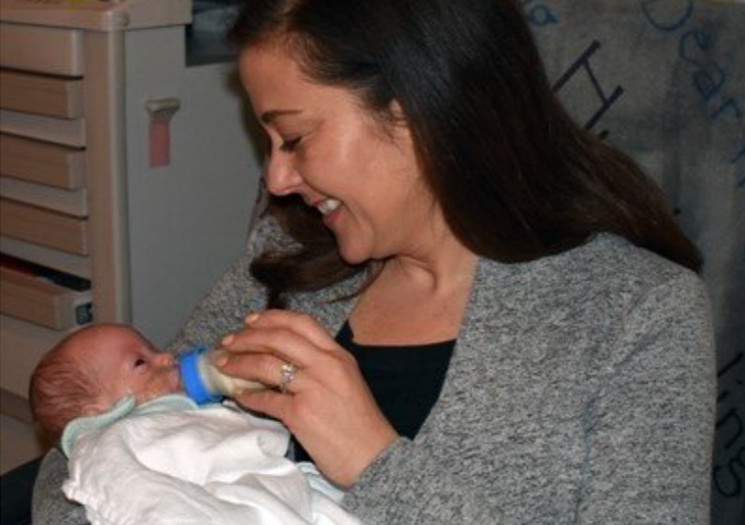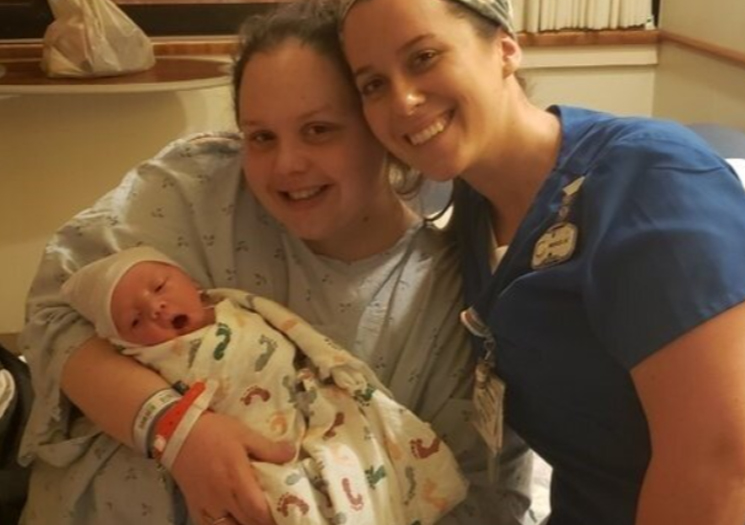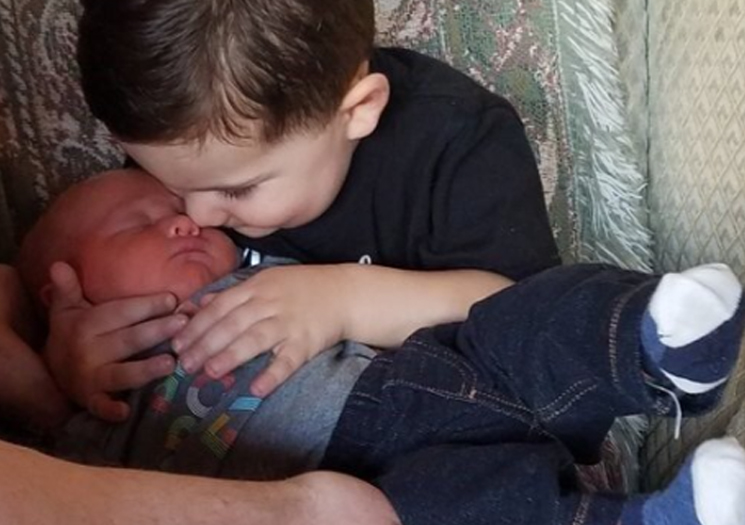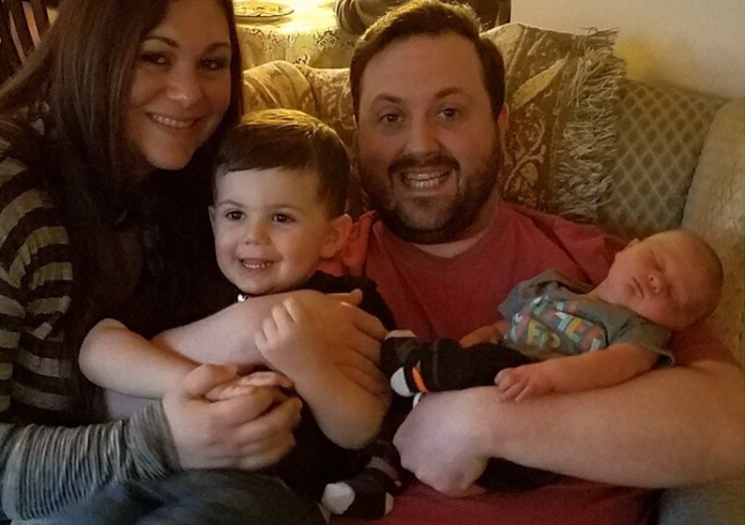- Find a Provider
-
Services
-
Redeemer Health provides compassionate care across every stage of life.
- View all Services
-
- Patients & Visitors
- Locations
- Careers
categories:

When Kate and Stefan’s twins entered the world, the couple knew their lives were about to change but they had no idea the many ways how.
Alex and Avery were born premature on December 23, 2018 and weighed 1.6 pounds and 1.7 pounds respectively. They were immediately transported to Holy Redeemer’s Level III Neonatal Intensive Care Unit (NICU).
As the babies were stabilized, the doctors carefully explained everything. Kate and Stefan would need to prepare themselves for a long NICU journey. The couple was in the process of moving and their home was hours away. They would need accommodations in the area to stay close to their babies. The Sisters of the Redeemer offered the Province Center as refuge. Grateful for the offer, Kate was able to secure accommodations at a nearby Marriott.
Under the watchful eye of Holy Redeemer’s NICU nurses and doctors, the tiny twins fought to grow stronger. But Alex was struggling and became ill. On December 29, he was transported to Children’s Hospital of Philadelphia (CHOP) for specialized treatment. Not only were Kate and Stefan away from their home, but now their babies were being treated in two different locations.
“We were thrown into a complex situation and had no idea what we were doing,” Kate said.
Kate and Stefan spent Monday through Saturday at the NICU and slept at their hotel. On Sundays they would go back home to New Jersey to wash clothes and pack for the following week. Kate says the only comfort she had on Sundays was knowing that the NICU nurses were keeping watch over her babies. When given the chance to transfer the twins closer to home, both Kate and Stefan refused. They knew their son and daughter were receiving the best care imaginable.
“The nurses became our family December 2018.They coached us and helped us navigate the care process. Everything from medical paperwork to basic premature baby care. It was incredible,” Kate said. One evening the NICU nurses surprised Kate and Stefan with a homemade lasagna. As they sat down to enjoy their first home cooked meal in weeks, they cried tears of gratitude. The simple gesture meant the world to the NICU couple.
As 2019 began, Kate adjusted to becoming a new mom. Avery was making a lot of progress but Alex was still ill at CHOP. On January 9th, shortly after Alex’s godparents had the chance to meet him, he passed away.
“Avery gained an angel that day. I know her brother is looking down on her,” Kate said. Kate’s NICU family didn’t leave her side. The nursing staff sat with her, talked with her and helped her through the grieving process while supporting baby Avery each day. Kate felt surrounded by sisters, mothers and friends.
“If it wasn’t for them I don’t’ know what we would have done,” Kate said.
By March, Kate had become a staple in Holy Redeemer’s NICU. While she was excited for the day she could bring Avery home, she almost didn’t want to leave. The staff had become such a part of her and Avery’s life, but the day finally arrived when Kate, Stefan and Avery could go back home and be together forever.
“I want to thank them for their unbelievable compassion, their 24/7 care, their knowledge and coaching,” Kate said. “Everyone treated us with extraordinary kindness. We will never forget each nurse and doctor who touched our lives.”
When Kate’s employer, Kohl’s Corporate, heard her story, they felt immense gratitude for Holy Redeemer’s NICU and staff. Wanting to give back, Kohl’s offered to co-host a 6K walk/run. The event was held on Saturday, September 14th in honor of Kate, Avery, Alex and the angels of Holy Redeemer’s NICU and raised $14,000 for the NICU.
categories:

Kenneth Larsen, 68, spent over 20 years working as a New York City subway engineer. He started out as a porter, sweeping the subway stations. Then he worked his way up to conductor and climbed up and down the subway trains as part of his job. Eventually, Larsen became a subway engineer. In this role, he would climb up and down the train and stop and start the train every twenty seconds for at least two hours straight. His long-time career meant over 20 years of repetitive arm movement which, as Larsen aged, led to chronic shoulder pain.
At first, Larsen treated his shoulder pain with Tylenol. When that wouldn’t numb the pain, his primary care physician recommended injections. However, Larsen was told he couldn’t stay on the injections forever. Larsen decided to get arthroscopic surgery to repair the tears in his rotator cuff. Unfortunately this was a temporary fix. Four years later, Larsen considered shoulder replacement surgery.
“It got so bad I could barely raise my arm,” Larsen said.
A friend of Larsen’s had her knee replaced by Dr. Seth Krum of Pennsylvania Orthopedic Associates. She had such great results; Larsen requested to go there too.
That friendly referral led Larsen to meet Dr. Nick Phillips, an orthopedic surgeon who specializes in upper extremities . In March 2018, Larsen had his right shoulder replaced.
“The surgery was successful and I started rehab right away,” Larsen said. “My physical therapist was amazed at how well I recuperated. I finished my physical therapy in six months when it normally takes a year.”
Seven months later, November 2018, Larsen had his son and grandson come up from Florida to visit him. The trio went to a Sixers basketball game, watched auto racing and participated in ax throwing for nearly three hours.
“We were so good, the ax master went out to his car and got a larger ax,” Larsen said. “That goes to show you how well I improved and recovered. I could throw that ax with no problem whatsoever.”
Today Larsen gets to enjoy the activities he loved before his shoulder pain got in the way. He is an usher at his church parish and volunteers monthly at Pennypack Park. He plans to get his left shoulder replaced sometime next year.
“Thank God, for that practice,” Larsen said. “The whole point of surgery is to be able to go back to life and have fun.”
To learn more about our orthopedic services visit Redeemer Orthopedics
categories:

Swaddling, a child care technique used universally for thousands of years, has started gaining popularity with parents interested in getting back to basics. It involves snugly wrapping a baby’s body with a light blanket so that only the baby’s head is exposed. Almost like giving your infant a nice big hug, the idea is to create a warm and safe feeling as the infant adjusts to life outside of the womb.
Swaddling helps combat over stimulation and prevents the newborn startle ‘moro’ reflex from waking an infant, calms restless infants down, and helps them fall asleep and stay asleep longer. It is especially helpful for colicky babies or if a baby is just fussy for no apparent reason.
It is easy to get started, any large thin soft blanket will work
- Lay a square blanket down on a flat surface so that it looks like a diamond. Fold the top corner down about 6 inches toward the center of the diamond; the top edge now forms a straight line.
- Place baby on her back face up in the center of the blanket with shoulders just below the fold. Her body should extend straight down toward the bottom corner.
- Gently hold your baby’s left arm straight down along her side. Then take the left side of the blanket and wrap it over her left arm and across her chest. Tuck the blanket underneath her right arm and to the back. At this point your baby’s left arm will be covered but her right arm will be free.
- Fold the bottom corner of the swaddle up and over baby’s feet. Tuck the point of the fabric into the top of the swaddle under the baby’s chin.
- Straighten your baby’s right arm and pull the right side of the blanket over your baby’s arm and body, tucking snugly underneath her left side.

The American Academy of Pediatrics believes that swaddling can be effective, but advises parents to make sure they are doing it correctly.
The swaddle should be snug, but not too tight. Make sure you can place two to three fingers between your baby’s chest and the blanket. To allow for the baby’s legs to move freely, the blanket should be loose around her hips.
Swaddling too tightly can overheat your baby so check that she is not flushed or sweating. Don’t overdress the baby under the swaddling blanket.
Always lay your swaddled baby down on her back and make certain that the blanket corners are tucked in underneath the baby.
If your baby doesn’t seem to like being swaddled, try it a few times before giving up completely. Around 2 to 3 months as your baby gets more active and starts to roll, she will outgrow the need for swaddling.
categories:

A two day series on Thursday evening 7:30pm to 9:30pm and Saturday morning 9:00am to 1:00pm, focuses on the role of the mom's support person and comfort measures, including conscious relaxation and breathing techniques.
Taught by registered nurses who are certified childbirth educators, these classes also provide a primer on what to expect during labor, birth and the postpartum period.
Moms are encouraged to dress comfortably and bring two pillows and a blanket for relaxation purposes.
The class includes a tour of the Maternity Center. Recommended for women in their seventh or eighth month of pregnancy and their partners.
For more information call 1-800-818-4747.
A tour of the Maternity Center is included.
categories:

“Hormonal changes and weight gain are part of a normal pregnancy,” says Valerie Rabinovich, M.D., OB/GYN at Millennium OB/GYN at Redeemer Health System. For at least nine out of every 100 pregnant women, these changes cause a rise in blood sugar, resulting in gestational diabetes.
Diabetes is a condition in which too much sugar stays in the blood instead of being used for energy. Health problems can occur when blood sugar is too high. Some women develop diabetes for the first time during pregnancy. This condition is called gestational diabetes. Women with gestational diabetes need special care both during and after pregnancy.
Address Your Risk
Diabetes can occur in women who have no risk factors, but it is more likely in women who
- are overweight
- are physically inactive
- had gestational diabetes in a prior pregnancy
- had a baby over 9 pounds in the past
- have high blood pressure
- have a history of heart disease
- are of African American, Asian American, Hispanic, Native American, or Pacific Island background
“It is standard for every pregnant woman to be tested for diabetes around 24 to 28 weeks of pregnancy regardless of risk factors,” says Dr. Rabinovich. If you have risk factors, your blood sugar will be tested early in pregnancy. The most common test used in the U.S. is to drink a sugary liquid and get a blood test one hour later. If this shows a high level, a second, confirmatory test is done.
Lifestyle Changes are Key
Left untreated, gestational diabetes can cause problems for you and your baby. When a woman has gestational diabetes, her body passes more sugar to her baby than it needs. With too much sugar, her baby can gain a lot of weight. “A large baby, weighing 9 pounds or more, can lead to complications for the woman, including labor difficulties, cesarean delivery, heavy bleeding after delivery, severe tears in the vagina and the anus with a vaginal birth, “ says Dr. Rabinovich
Fortunately, treating gestational diabetes can help prevent these problems. For many women, a healthy diet and regular exercise will control blood sugar. Some women may need medications to help reach normal blood sugar levels.
- Know that what you eat, how much you eat, and how often you eat all affect blood-sugar levels
- Eat three small meals and two to three small snacks a day
- Choose smaller portions of healthy foods such as fruits, vegetables, whole grains, and low-fat dairy products
- Limit sweets
- Exercise for 30 minutes or more at least five days a week
“Walking is a great exercise for all pregnant women. “ says Dr. Valerie Rabinovich.
After your pregnancy
Having gestational diabetes increases your risk of developing diabetes in your next pregnancy and in the future when you are no longer pregnant.
You should have a blood test 12 weeks after you give birth. If your blood sugar is normal, you will need to be tested for diabetes every 1–3 years.
Lastly, Dr. Rabinovich would like to you to remember - if you are diagnosed with gestational diabetes do not panic! Instead, use this special moment in life to make changes for a healthier pregnancy and your overall health after your baby is born.
categories:

If you or a loved one is suffering from depression during pregnancy or after childbirth, you are not alone. “Many new moms have feelings of sadness and anxiety, and a percentage of pregnant women and new moms can experience a complication of pregnancy known as postpartum depression,” says Patricia McGettigan, M.S., Clinical Psychologist and Administrative Director of Holy Redeemer Counseling Center.
Most new moms experience some form of “baby blues,” feelings of sadness or worry lasting about two weeks after childbirth. For some women, these feelings do not go away and become worse. If you or a loved one is experiencing this ongoing depression, talk with your doctor. It may be postpartum depression, a mood disorder that affects about 15 percent of new moms.
If you are pregnant, you are also vulnerable to depression – it affects about 10 percent of expectant mothers. And about half of women with postpartum depression had symptoms during pregnancy. Depression that occurs both during pregnancy and up to 12 months after childbirth is called perinatal depression.
“Depression during pregnancy or following the birth of your baby does not mean you are a bad mom,” says McGettigan. “It is a psychological disorder, and it is treatable.” Experts believe that hormonal changes may be to blame, but depression is not caused by one thing.
If you think you might be depressed, make an appointment with a licensed therapist at the Redeemer Health Counseling Center at 215-914-4190 or visit our Counseling Center page.
Another excellent resource, The Postpartum Stress Center. Cartoon image provided by Karen Kleiman, Molly McIntyre, The Postpartum Stress Center, and Familius (publisher).
categories:

“If it wasn’t for Holy Redeemer, I’m worried my son wouldn’t be here.”
Jessica H. was rapidly approaching her due date. At 32 weeks, Dr. Kavous Emami of Millennium OB/GYN referred Jessica to Maternal Fetal Medicine (MFM), just to keep tabs on her baby. Jessica attended her appointments each week as her baby showed no signs of wanting to leave the comfort of the womb. Her due date came and went. Four days after her due date, on March 20th, Jessica went for her ob appointment. Dr. Regina Dougherty asked, “Your bags are packed, right?”
Jessica laughed, but Dr. Dougherty was serious. Her blood pressure was through the roof and her baby needed to arrive that day. Jessica returned home to grab her go bag and was admitted into Labor & Delivery at 7:15pm despite no contractions.
A stress test concluded her baby’s heart rate was low. Jessica’s blood pressure continued to climb but her doctors and nurses kept her calm.
“They knew how bad it was but they didn’t want to stress me out,” Jessica said. “The triage nurses, L&D, doctors, everyone made my predicament seem like it was just another day on the unit.”
Jessica’s care team told her that she’d be delivering that evening. With no contractions and minimal dilation, Jessica was in complete disbelief. Her baby didn’t seem to be ready but the baby’s heart rate remained a concern.
The hours passed and labor finally began. Jessica was doubled over in pain and begged for the epidural.
“The anesthesiologist was amazing, I think everyone on the floor heard me yell for the epidural but my nurse, Allison and my anesthesiologist were so supportive, friendly and best of all, calm,” Jessica said.
Six hours and 36 minutes from start to finish, Jessica’s baby boy was born at 8lbs and 2 oz.
But the umbilical cord was wrapped around his neck and he wasn’t breathing right away.
“I swear every doctors from cardiology to endocrinology to neonatal was there making sure he was okay,” Jessica said.
Quick thinking and protocol was put in place and baby Michael was taken to the NICU for observation. He spent three hours on the unit before being released to the Maternity ward and into his anxious mother’s arms.
“When he was born, I thought there was a chance I wasn’t going home with him,” Jessica said. “If it wasn’t for Holy Redeemer, I don’t know if I would have come home with my child. I couldn’t be more grateful, he is healthy and happy.”
That evening, every doctor and nurse who worked with Michael and Jessica stopped by her room to make sure the pair was doing okay. Jessica felt like family. She wasn’t just “another patient” or a “number,” she was a person and she knew Redeemer Health cared about her and her son.
Now Jessica is home with her son and her two-year-old daughter, Mckenzie. She is adjusting to her role as big sister and finally enjoys helping her mom with her new brother.

categories:

Healthy eating is always important, but when you’re eating for two, it’s twice as important! The right foods can help boost your energy level and mood, while minimizing the negatives that come along with pregnancy, such as morning sickness. Below is a list of 10 foods that are excellent sources of vitamins and nutrients for you and baby:
Broccoli: Rich in fiber, abundant in calcium and fuels the body with disease-fighting antioxidants, broccoli is a vegetable that packs a nutritious punch. It is also a good source of vitamin C.
Bananas: These yellow fruit staples are rich in potassium and offer a quick burst of energy that can help fight off fatigue. Bananas are also easy on the stomach so if you’re feeling nauseated they are a great option.
Berries: Packed with water, healthy carbohydrates, vitamin C, fiber and best of all, antioxidants, berries are tiny superfoods that are perfect for snacking or to add to salads, smoothies or cereals. You can head to your local berry farm and pick from an array of in-season berries while spending the day outside with family and friends.
Sweet Potatoes: Vitamin A is another essential vitamin for you and baby. Sweet potatoes are an easy way to get a good dose of vitamin A. They are also high in vitamin C, folic acid, and fiber, which are all important nutrients for any stage of pregnancy.
Whole Grains: Whole grains are high in fiber and nutrients, including the antioxidant Vitamin E and various minerals. There are lots of different options to choose from such as barley, buckwheat, oats and spelt. Today you can find a variety of whole grain breads and cereals as well, just be sure to choose products that have not been processed.
Greek Yogurt: Did you know Greek Yogurt has twice the protein of regular yogurt? Many brands also offer half the sugar too. Greek yogurt is a great source of probiotics and calcium. Calcium helps keeps bones strong and contributes to the growth of a healthy skeleton for your baby.
Eggs: These protein powerhouses have amino acids that are the building blocks of cells in your body and your baby’s body. Egg yolks also contain choline, which helps your baby’s brain and spinal cord develop.
Salmon: Omega-3 fatty acids are essential for your baby’s neurological and visual development. Best of all, salmon is a mood booster that is a low-mercury seafood option.
Lean Meats: For high-quality protein, turn to lean meats such as skinless chicken and turkey, pork chops, and lean beef.
Avocado: Considered a superfood, avocados are full of healthy fats and offer nearly 20 vitamins and minerals in every serving including potassium, which helps control blood pressure, lutein, which is great for eye health and folate, a B-vitamin which assists with cell repair.
There are many delicious and healthy food options to choose from when eating for two. Check out recipes online to find new ways to prepare these nutritious staples and enjoy every bite during your pregnancy journey.
categories:

When Nicole and Joe Harrigan of Tacony, were pregnant with their second child, they were very surprised. First of all, they thought their baby was a girl throughout the entire pregnancy. But on March 26th, Nicole gave birth to a beautiful baby boy. That wasn’t the only surprise. Aidan was 10 pounds, 2 ounces, 22.5 inches long and four weeks early.
Despite being a healthy size, Aidan had some breathing difficultly and was admitted to Holy Redeemer Hospital’s Neonatal Intensive Care Unit for specialized treatment. He was placed on a CPAP machine, given a feeding tube and monitored closely.
“It was really scary,” Nicole said.
Aidan was a healthy size, but he still needed some extra care during his first few hours in the world. Fortunately he could breathe on his own by the end of the day. Any time Nicole or Joe had a question, their nurses were ready with answers.
“Our nurses were really great,” Nicole said. “They carefully explained everything and didn’t make us feel stupid for asking so many questions.”
Nicole was eager to bring her son home. Her firstborn, Joey, turned two on March 3rd. She wanted the whole family to be together.
“You feel bad. When you’re home, you’re away from your newborn and when you’re at the hospital, you’re away from your toddler,” Nicole said.
Aidan made exceptional progress and after several days he graduated the NICU and could finally go home. Now a two-child household, Nicole and Joe were nervous about how Joey would react to their new addition. As soon as Nicole introduced Aidan to his older brother, Joey said, “Hi baby” and handed Aidan his pacifier. It was perfect.
With two very different birth experiences at Holy Redeemer Hospital, Nicole is still immensely grateful to the staff who care for her and her sons.
When asked what advice she has for other NICU moms Nicole said, “It is just temporary. It is going to be difficult but you can get through it. The most important thing is that your baby is healthy.”

categories:

The bond between mother and child is one of the most important connections humans can make. But the bond between father (or a father figure) and child is just as vital.
“The impact of a father’s presence—or absence—in his children’s lives can have lifelong effects,” says Joel Kramer, D.O., OB/GYN at Kramer OB/GYN and Associates, a Redeemer Health practice.
Fortunately, today’s culture encourages men to go beyond traditional roles and become involved, caring supporters of their children.
Studies Show Dad’s Influence
A father’s presence can enhance his child’s life from birth. In one study, premature babies showed improved weight gain in the hospital if their fathers visited often. The infants also did better on developmental tests during their first 18 months. Research points to other unique contributions of fathers:
- Fathers help their children develop intellectually and socially through physical play. Mothers are more likely to talk and teach.
- Children whose fathers take part in their lives are more likely to have higher college entrance exam scores, greater educational success, and better economic status.
- Teens who feel close to their fathers—even if the fathers don’t live with them—are far less likely to smoke.
- Having a father who exercises is the single biggest factor in whether or not teens are physically active, according to another study.
- A healthy, involved father can help ease the impact on children if their mother suffers from depression or other mental health issues, research shows.
Be a Healthy Role Model
Support children’s schooling. Know who your children’s teachers are and attend parent-teacher conferences. Volunteer for school activities. Talk with your children about what’s going on at school.
Be a positive parent. Establish clear limits so that children know your expectations. “Encourage children to share their feelings and listen attentively,” says Dr. Kramer. “Help them set achievable goals and celebrate their accomplishments.”
Have fun. Play games, go places, read together, tell jokes, and share plenty of affection.
Model healthy habits. Exercise regularly; eat a healthy, low-fat diet; and don’t smoke. “Actively encourage children to follow a healthy lifestyle,” says Dr. Kramer. “Play physical games with them, offer healthy foods, and limit TV and video-game time.


